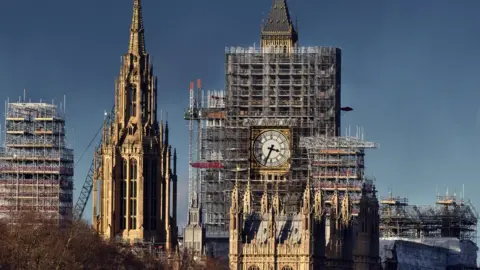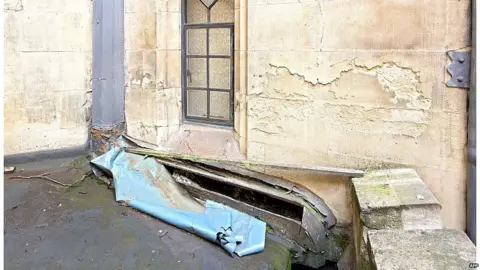Is Notre-Dame fire a warning for UK Houses of Parliament?
 BBC
BBCAfter the devastating fire that engulfed Notre Dame, MPs in the UK have started to fear for another iconic building closer to home.
The Houses of Parliament in London mostly date from the 19th Century, but some parts go back as far as 1099.
The estate is in desperate need of repair, with an outdated electrical system being just one of the "critical risks" to the Grade I listed building.
Labour leader Jeremy Corbyn said the fire in Paris should serve as a "warning" to get the work done.
And Leader of the House of Commons Andrea Leadsom said it was a "crucial reminder of the importance of preserving our historic buildings".
There is a plan for a full "Restoration and Renewal programme" for the site, but what will it involve and when will it take place?
What are the issues with the building?
Much of the building's mechanical and electrical systems, such as heating, lighting and power, were installed into the building after World War Two and should have been replaced in the 1980s.
But Tom Healey, the restoration programme director, said Parliament had taken a "patch and mend approach" instead, to keep systems plodding along despite being way beyond their shelf life.
Other issues include:
- Steam, gas and water services being built on top of each other and next to high voltage electricity wires - posing a major risk to both
- A lack of disabled access into both the Commons and Lords
- Almost 200 miles of telephone, broadcasting and sound cabling needing to be upgraded
- Over 1,000 spaces containing asbestos
What is the plan for future works?
The Palace of Westminster Restoration and Renewal Programme aims to make the building fit for the 21st century in one single phase.
It will bring the site up-to-date, including ripping out and replacing 240 miles-worth of cabling, installing a new sewage system and improving access.
But to do this, MPs and peers need to move out to allow the work to be done.
 UK Parliament
UK ParliamentIn early 2018, both Houses agreed this was the best and most cost-effective way to carry out the upgrades, and now a bill is working its way through Parliament to set up a body to create the plan and oversee it.
But again, this work is going to take time.
Before the programme can get going, a number of things need to happen, including developing a detailed design brief and budget to be signed off by Parliament, and designing and testing out temporary accommodation.
Richmond House, on Whitehall - near the existing Palace of Westminster - is the preferred location for the temporary Commons, while the Queen Elizabeth II Centre - a stone's throw from Parliament Square - is preferred for the Lords.
 AFP
AFPTo allow time to get all this preparation done, the programme isn't expected to begin until the mid-2020s.
It is also too early to say how much the works will cost, as a more exact figure will not be known until the body in charge makes its business case.
However, in 2015, the Independent Options Appraisal did identify indicative, relative costs for a range of the options, and estimated the one phase programme would cost between £3.52bn and £3.87bn, at 2014 prices.
What work has taken place so far?
Some issues were deemed too urgent to wait for the full programme to start, hence why some of the buildings are already covered in scaffolding.
This includes work to Elizabeth Tower - home to Big Ben - where the roof will be stripped off and restored, the bell frame repaired, leaks into the clock room stemmed and a lift installed.
A brick enclosure in the tower will also be replaced with glass to allow Big Ben to be viewed by people walking up the staircase.
A major project to improve fire safety across the estate was also completed last year, including upgrades to fire doors, new signs and a high pressure water mist system.
Teams of fire safety officers also patrol the buildings 24 hours a day to spot any fire safety issues.
Has Notre-Dame quickened the timetable?
It has definitely increased attention to the issue from MPs, including from Labour's Chris Bryant.
Allow X content?
But there is still so much work to do, it is hard to see the process being sped up.
A Parliamentary spokesman said: "Fire safety is a key priority for Parliament and protections are constantly reviewed and updated, including at our active construction sites, and in planning for the future restoration and renewal of the Palace of Westminster.
"We stand ready to learn any lessons that emerge from the fire at Notre Dame to ensure we do everything possible to protect our people and buildings on the Parliamentary Estate."